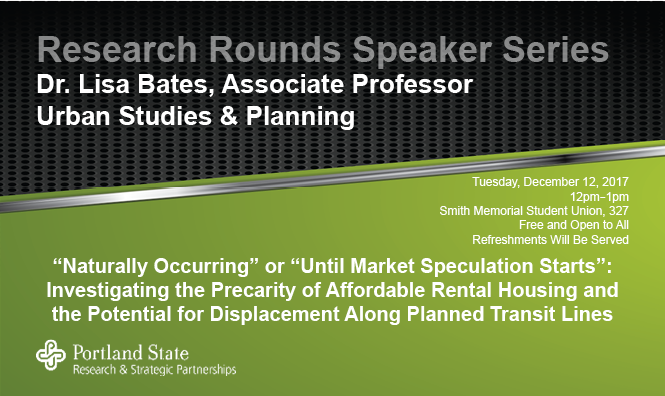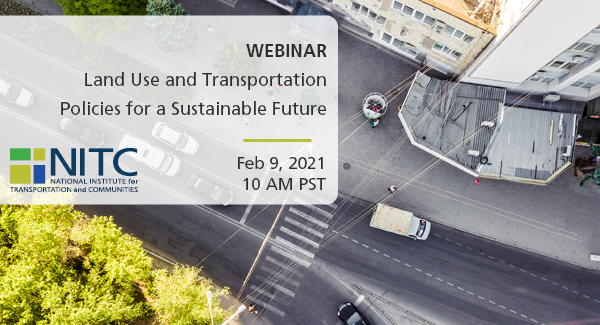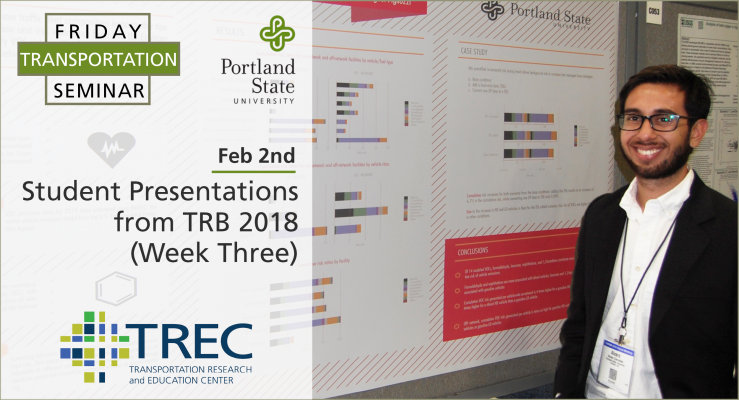The video begins at 3:49.
This event was hosted by Portland State University's Research and Strategic Partnerships. See the schedule for the monthly Research Rounds Speaker Series here.
REVISIT THE LECTURE: VIDEO AND SLIDES
Miss the lecture or want a look back at the presentation? Watch the video, or view the presentation slides here.
"Naturally Occurring" or "Until Market Speculation Starts":...
Read morePRESENTATION ARCHIVE
OVERVIEW
Even though there are tremendous uncertainties in the timing and evolution path of the Autonomous Vehicles (AV) technology, it may become a likely reality within most MPOs' long-range regional transportation plan horizon of twenty years. Yet a recent survey of the largest MPOs in the US indicates only one of them "even mentions driverless, automated, or autonomous vehicles in its most recent RTP". One of the uncertainties in assessing the impacts of AV is their direction: on one hand, self-driving cars could increase VMT by increasing roadway capacity, lowering costs of travel; on the other, they may reduce VMT by enabling more car-sharing, improving access to transit, eliminating the fixed costs of car ownership, and reclaiming parking space. To date, there is no suitable conceptual framework or modeling tools available to MPOs for quantitatively assessing the likely long-term effects of AV or potential policy scenarios.
This project studies the possible impacts on travel and land use of the emerging AV technology and focuses on advancing this innovative mobility option by...
Read moreThe video begins at 1:20.
View slides: Foster Presentation (PDF)
View slides: Muhs Presentation (PDF)
View slides: Wagner Presentation (PDF)
Summaries:
Evaluating Driver and Pedestrian Behaviors at Enhanced Multilane Midblock Pedestrian Crossings: Case Study in Portland, Oregon This study examines driver and pedestrian behaviors at two enhanced midblock pedestrian crossings in Portland, Oregon. One crossing is on a five-lane arterial with a posted speed of 35/45 miles-per-hour (MPH) and features six rectangular rapid flash beacon (RRFB) assemblies and a narrow median refuge. The other crossing is on a suburban arterial with four travel lanes and a two-way left-turn lane. The crossing is enhanced with four RRFB assemblies and a median island with a “Z” crossing, or Danish offset, designed to encourage pedestrians to face oncoming traffic before completing the second stage of their crossing. Approximately 62 hours of video have been collected at the two locations. A total of 351 pedestrian crossings are analyzed for driver compliance (yielding) rates, pedestrian...
Read moreSteve Szigethy and Jamison Kelleher, a team of graduate students in PSU's Master of Urban and Regional Planning program, will present their Planning Workshop project entitled "Imagine 82nd." The project engaged residents, businesses, property owners and students along NE 82nd Avenue in Portland to develop a comprehensive vision for the future of the corridor. Imagine 82nd deals with the portion of 82nd Avenue between the Banfield Expressway and NE Sandy Boulevard, 1.3 miles in length. This particular stretch is home to many retail and service businesses that typify the rest of 82nd Avenue, but it also includes Madison High School, a major corporate headquarters, and a 20-acre vacant brownfield site. At this seminar, Steve Szigethy and Jamison Kelleher will present the vision concepts they developed with the community, with particular emphasis on transportation and land use components.
The video begins at 5:54.
tr*NEW* LOCATION: Karl Miller Center at PSU, 631 SW Harrison St., Room 465
*NEW* REGISTRATION: Sign up through GoToWebinar
Portland State University students share the work they presented at the annual meeting of the Transportation Research Board (TRB) 2018:
SEMINAR VIDEO
Read more




